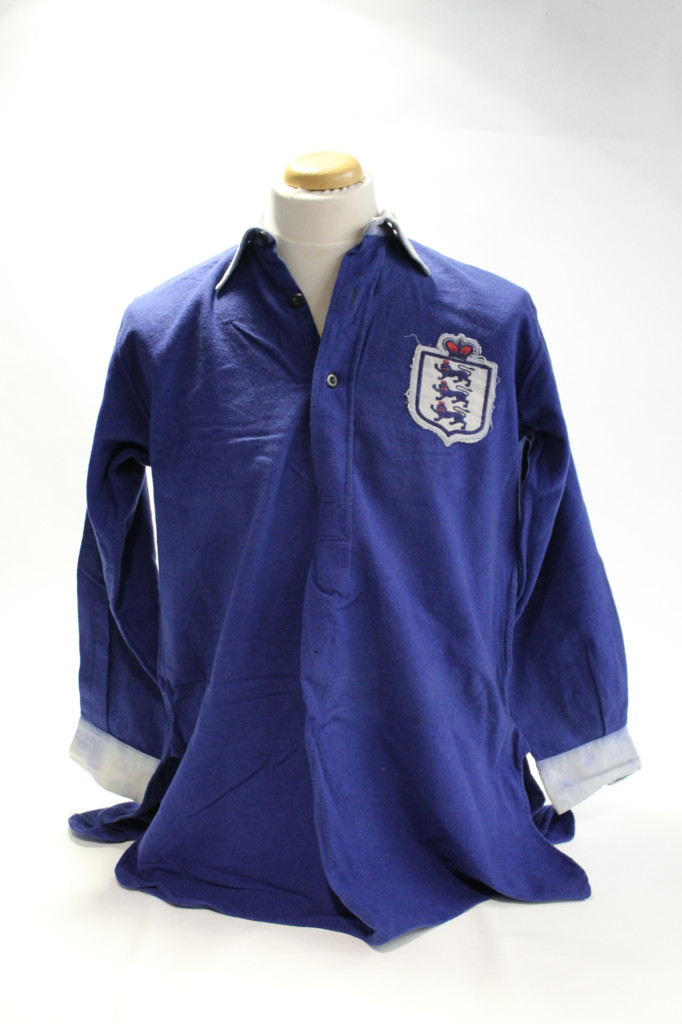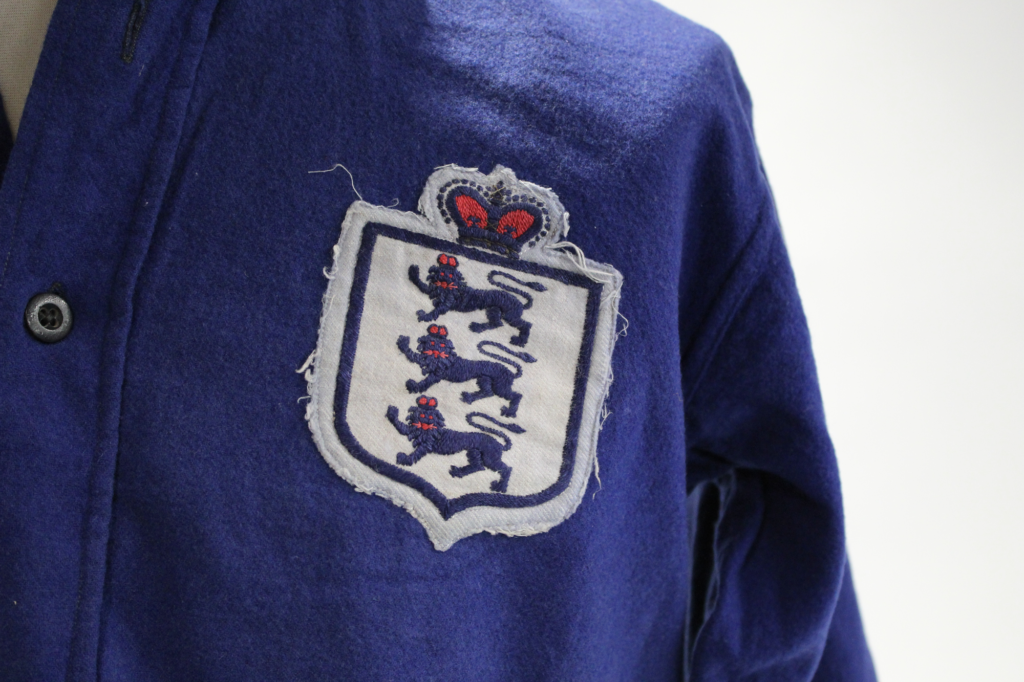On the 4th of December 1935, England took on Germany at White Hart Lane in London. This was a historic fixture in that it was the first full international fixture to take place between the two teams in England.
However, today the fixture is seen as one of the darkest events in English football history, as it was when the Swastika flag was flown from the flagpole at White Hart Lane.
The game was subject to considerable debate and public protest about the connections between sport and politics that have left lasting questions that are still asked today. We are lucky to have Frank Moss’ rare blue England change shirt from this contentious fixture on loan to us as part of The Players Foundation collection.

When it was announced that the English and German teams would meet for the first time on English soil at White Hart Lane, the home of Tottenham Hotspur, the public, press and radio discussed its possible implications widely. White Hart Lane has always been a stronghold of Jewish support due to the surrounding North London Jewish communities, and there were Jewish players amongst the team.
At the time, the German National Socialists had been in power for two years, and the Nuremburg Laws of September 1935 had just stripped Germany’s Jewish citizens of their basic human rights. To say White Hart Lane was a sinister and insensitive choice for the venue of this fixture is an understatement.
With both governments pursuing an agenda of appeasement, the British decided to go ahead with the game. The following months that preceded the match were marked by protests by Jewish groups, fan groups and trade unions. The Jewish Trade Union demanded the immediate cancellation of the match, and the British Anti-Nazi Council launched a mass campaign that would not stand for the fixture going ahead anywhere in the country, not just at White Hart Lane.
15,000 protest postcards were printed and so were posters concerning the alleged murder of a Jewish footballer in Germany. The public interest centred increasingly on the thousands of German fans about to fly into London, billed in the press as a “smiling army of 10,000” and “just a team who come to play sport”.
The British Home Secretary Sir John Simon informed a Trade Union Congress meeting objecting to the match that he wanted to uphold England’s tradition of keeping sport and politics separate. The captain of the German team Fritz Szepan told the British press that “Herr Hitler has sent us no message. We are here as sportsmen to play against the best footballers in the world.” And so, the fixture went ahead.
Protests continued and on the day of the match a demonstration march converged on White Hart Lane. As kick-off approached, tension mounted. A large parade of placard-wielding protestors left the nearby Bruce Grove station two hours before the match and proceeded towards the ground handing out leaflets. As they approached the ground the police moved in and began tearing down the placards which proclaimed ‘Our Goal, Peace: Hitler’s Goal, War’; ‘Hitler Hits Below the Belt’ and ‘Keep Sport Clean, Fight Fascism’.
To all observers from both sides of the debate, the size of the police presence was staggering. Over 800 police were on duty and a temporary police station had been set up close to the ground, while reserves waited in the pavilion of a neighbouring school. Policemen lined the road to the ground, and inside the ground where they were positioned round the pitch at 10-yard intervals.
Despite the protests and rising tensions, the game went ahead without incident. The Swastika flag flew from the flagpole and the German team did the Nazi salute as if this was normal practice. England went on to win 3-0, and all discussions about the political legacy of the game ended. That was that. The fixture actually went on to be seen as a success and talks of a return fixture began soon after.
The two teams met again at the Olympic Stadium in Berlin on the 15th of May 1938. During the intervening period between the two fixtures, Germany invaded and annexed Austria in violation of the 1919 Treaty of Versailles. Britain and Europe were witnessing overt German expansion and aggression, yet there was perhaps even less questioning of if it was the right thing to do to let the fixture go ahead. The English team headed over to Berlin, and only an hour before the game, they were informed they would be required to give the Nazi salute.
They were assured by their manager that this decision had not been taken lightly, but the FA member in charge of the England team gave the request having attended the 1936 Berlin Olympics during which Hitler had taken offense to the British team’s failure to acknowledge him. Britain’s ambassador told the players that the salute would not constitute and endorsement of the Nazi regime and so the team carried out the request. Sir Stanley Matthews later wrote: “All the team were livid. Eddie Hapgood, a respected and devoted captain, told him where he could put his Nazi salute.”
England won this fixture 6-3, and again little attention was given to the incident. The Times even congratulated the players for respecting their hosts and there was little anger in the rest of the press. Some letters from the public criticising the team did appear in the papers at the time but much of the outrage only blossomed many years later. In 2003, the BBC labelled the moment “one of the darkest moments in sport.”
Even the supposed disgust of English players was only expressed much later in the decade following the war. The imagery from both games, however, has left a lasting legacy. Amidst more frequent calls for boycotts at the same time as calls for keeping politics and football separate, we can learn from these two chilling occurrences that hatred never had a place and never will.
You can find out more about The Players Foundation and their work via their website below.
